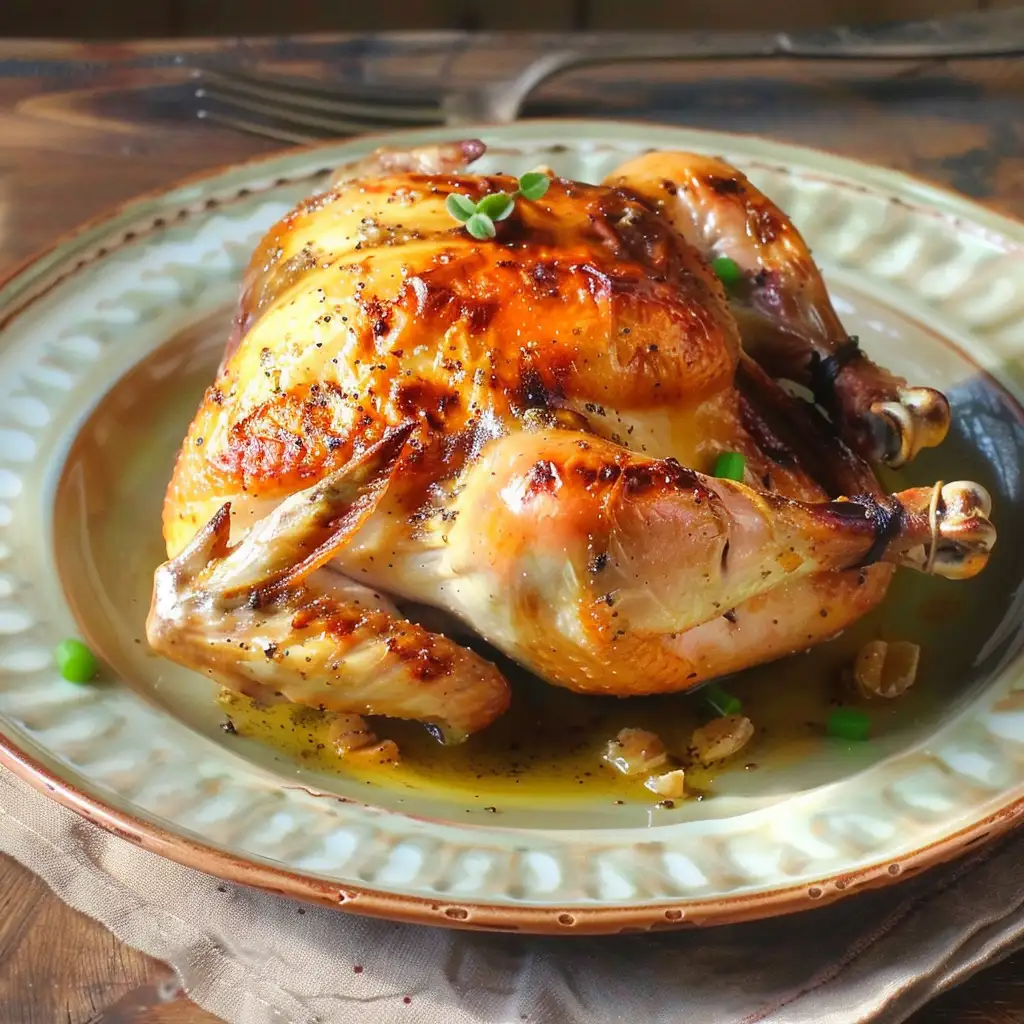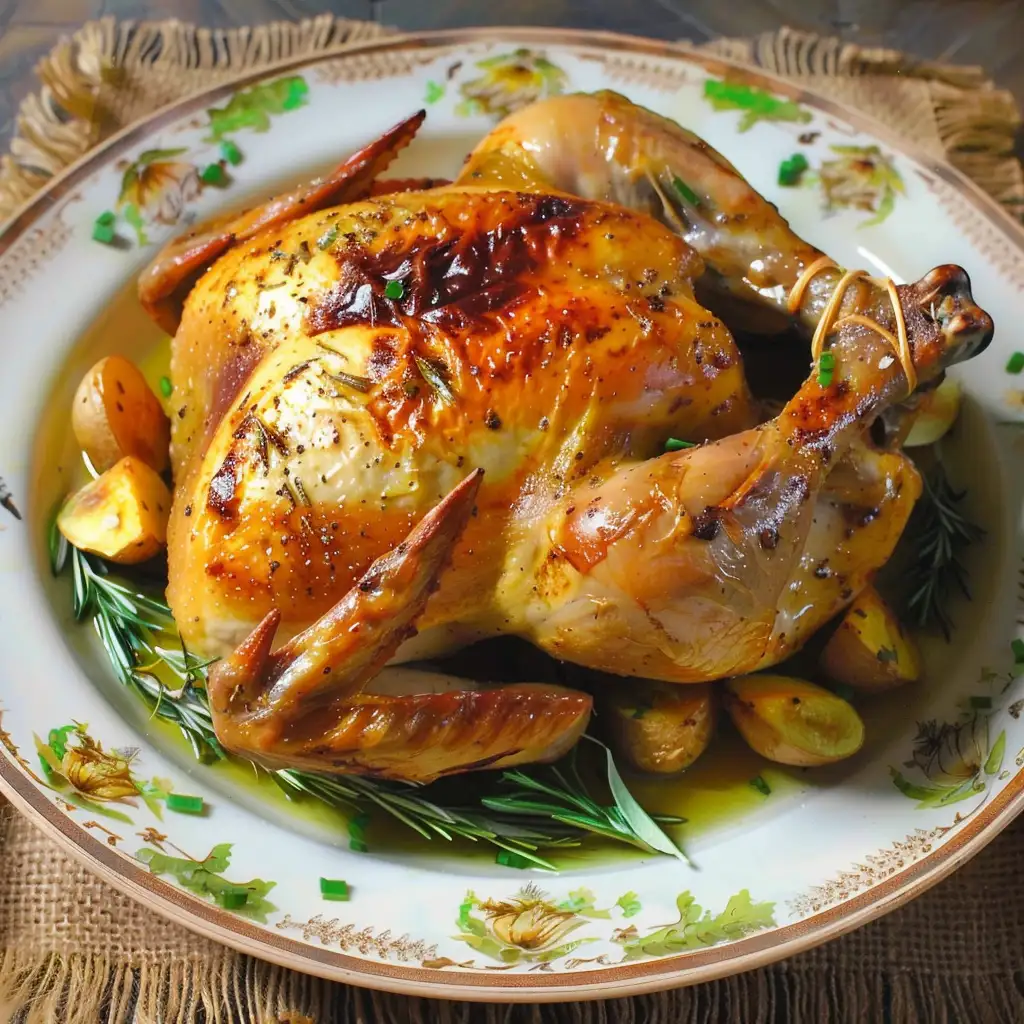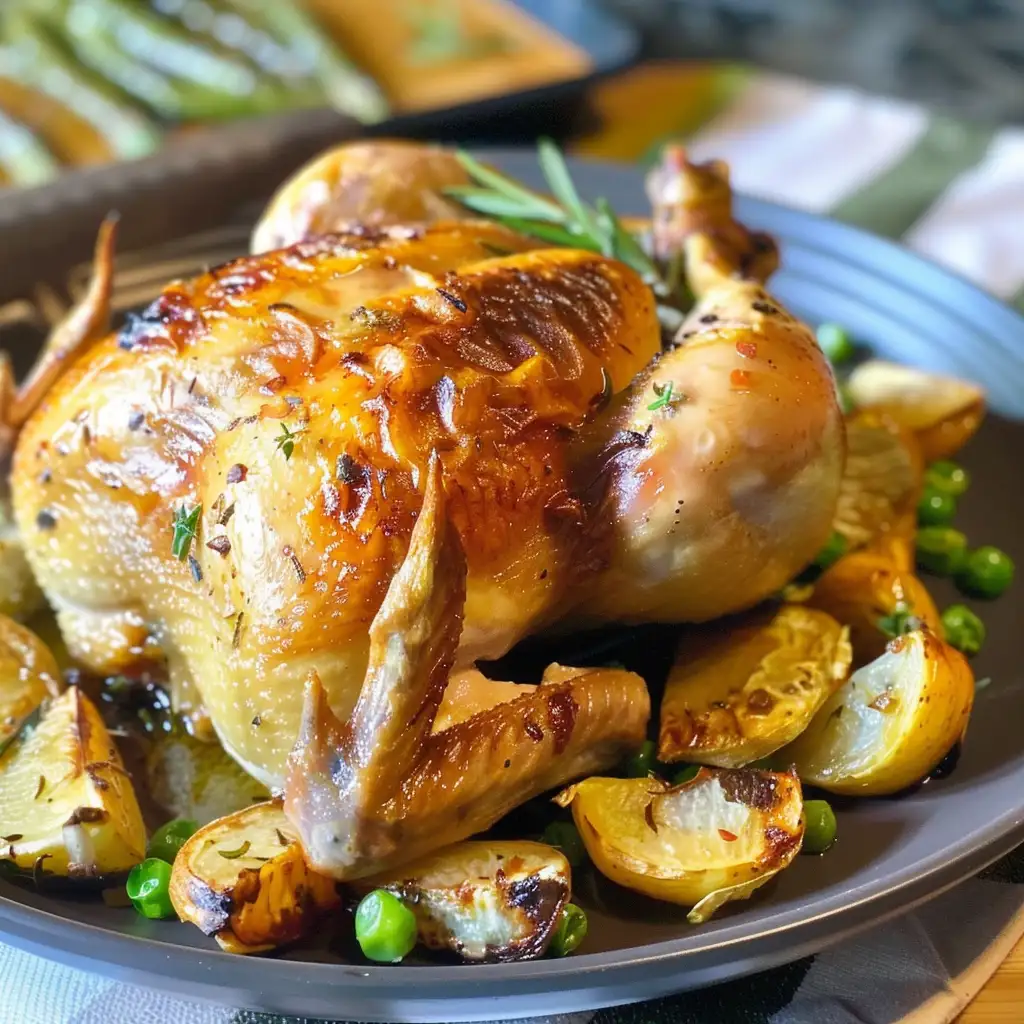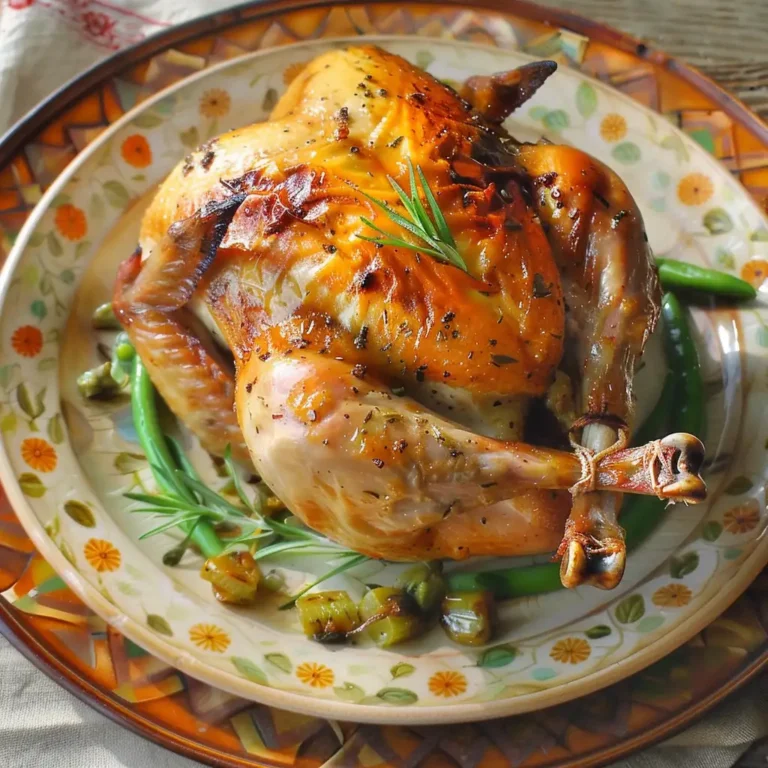Introduction to Roast Chicken
Roast chicken holds a timeless appeal as a dinner centerpiece, revered across cultures for its simplicity, deliciousness, and the warmth it brings to any table. Its history stretches back centuries, transcending geographical boundaries to become a symbol of comfort food around the globe. The cultural significance of roast chicken is profound, often featured in festive and celebratory meals, signifying abundance, warmth, and familial love.
The Art of Roasting Chicken
Roasting chicken is an art that marries simplicity with sophistication. The decision to roast a chicken yourself brings numerous benefits, elevating a simple meal into something special.
Why Roast a Chicken Yourself?
- Homemade roast chicken not only surpasses the flavor and texture of store-bought versions but also allows for complete control over ingredients, ensuring a healthier meal.
- The process of roasting chicken at home is imbued with a sense of accomplishment and offers a more engaging culinary experience.
Roast Chicken vs. Rotisserie:
- Cost: Homemade roast chicken often proves to be more economical than its rotisserie counterpart. On average, a whole raw chicken costs significantly less per pound than a prepared rotisserie chicken, offering better value and a larger quantity of meat.
- Flavor and Health: Roasting your chicken allows for customization in terms of flavors and ingredients, enabling a healthier outcome free from the preservatives and additives often found in store-bought rotisserie chickens. According to the CDC’s advice on poultry preparation, handling and cooking your chicken properly can also mitigate health risks, making the homemade roast not just tastier, but safer.
- Customization: The ability to personalize your roast with a variety of herbs, spices, and infusions means every roast can be a new culinary adventure.
Creating a roast chicken at home offers a richer, more flavorful, and healthier dining experience compared to purchasing a rotisserie chicken. The savings on cost, coupled with the ability to tailor the flavors and ensure food safety, make it a clear choice for those looking to enjoy a classic dish in the comfort of their home. By following guidelines such as those provided by the CDC on safe poultry handling, you can enjoy the process of making your roast chicken as much as the delicious end result.
Preparing Your Chicken for Roasting
Preparing a chicken for roasting involves several key steps that can significantly affect the flavor, texture, and overall success of your dish. From selecting the right chicken to seasoning it perfectly, each step is crucial in achieving a delicious roast chicken.
Selecting the Right Chicken:
- Size: Aim for a chicken that weighs between 4 to 5 pounds. This size is ideal for ensuring even cooking and serving 4-6 people comfortably.
- Quality: Look for chickens labeled as organic or free-range. These options are often higher in quality, with better flavor and texture due to the healthier lives led by the birds.
- Preparation: Ensure the chicken is fully defrosted if previously frozen. A properly thawed chicken will roast more evenly.
To Wash or Not to Wash:
The debate on whether to wash poultry is a long-standing one. However, health guidelines from authoritative bodies like the Centers for Disease Control and Prevention (CDC) advise against washing chicken. Washing can spread bacteria like Salmonella across your kitchen through splattering water droplets.
- Safe Handling: Instead of washing, pat the chicken dry with paper towels. This will help remove moisture from the skin, contributing to a crisper end result.
Seasoning Secrets:
Seasoning your chicken well and in advance can elevate the taste to new heights.
- Why Season Ahead: Salt, when applied early, has time to penetrate deeper into the meat, enhancing flavor from within. This process, known as dry brining, also helps the skin dry out further, leading to crispier skin.
- How to Season: Generously season both the inside and outside of your chicken with salt, pepper, and any other desired herbs or spices. For best results, season the chicken and then let it rest in the refrigerator for at least a few hours, or overnight.
Stuffing and Trussing:
- Stuffing: For added flavor, stuff the cavity of the chicken with aromatics such as lemon halves, garlic cloves, and fresh herbs. These not only flavor the meat but also help to keep it moist.
- Trussing: Tying the legs together and tucking the wing tips under the body are simple techniques that help the chicken cook evenly, prevent the tips from burning, and improve presentation.
Proper preparation is the foundation of a delicious roast chicken. By selecting quality ingredients, handling them safely following CDC guidelines, and employing effective seasoning and trussing techniques, you can ensure a flavorful, moist, and perfectly roasted chicken every time.

Preparing Your Chicken for Roasting
Preparing a chicken for roasting is an art that can transform a simple meal into a feast. The process from selecting the right chicken to the final preparations before it goes into the oven is crucial for achieving the perfect roast.
Selecting the Right Chicken:
Choosing the right chicken is the first step to a delicious roast.
- Size: Aim for a 4- to 5-pound chicken, which is ideal for ensuring even cooking and serving about 4-6 people.
- Quality: Opt for organic or free-range chickens if possible, as they tend to have better flavor and texture.
- Preparation: If your chicken is frozen, ensure it’s completely thawed before cooking to guarantee even roasting.
To Wash or Not to Wash:
Washing chicken before cooking is a debated topic. However, health experts, including those at the Centers for Disease Control and Prevention (CDC), advise against it. Washing chicken can spread Salmonella and other bacteria through splashing water.
- Instead, pat the chicken dry with paper towels to remove moisture. This helps achieve crispier skin during roasting.
Seasoning Secrets:
Proper seasoning is key to flavorful roast chicken.
- Why Season Ahead: Seasoning the chicken ahead of time allows the salt to penetrate the meat, enhancing its flavor from the inside out. This technique, known as dry brining, also aids in drying out the skin for extra crispiness.
- How to Season: Liberally season the inside and outside with salt and your choice of herbs and spices. For the best flavor, let the seasoned chicken rest in the refrigerator for a few hours or overnight.
Stuffing and Trussing:
Stuffing and trussing the chicken are final touches that can make a big difference.
- Stuffing: Fill the cavity with aromatics like lemon, garlic, and herbs to infuse the meat with moisture and flavor.
- Trussing: Tying the legs together and tucking the wings helps the chicken cook evenly and maintains a good shape.
By following these steps, you ensure your roast chicken will be juicy, flavorful, and perfectly cooked. Remember, the key to a great roast starts with the basics: select the best quality chicken you can find, handle it safely per CDC recommendations, season it well, and give it the care it deserves in the preparation phase.
Roasting Techniques and Tips
Mastering the art of roasting chicken is all about understanding the nuances of cooking times, temperatures, and methods that bring out the best in your bird.
Oven Temperatures and Cooking Times:
The key to a perfectly roasted chicken lies in balancing oven temperature and cooking time.
- Start by roasting your chicken in a hot oven (around 450°F) for the first 20 minutes to seal in juices and start the crisping process of the skin.
- Lower the temperature to 375°F for the remainder of the cooking time to ensure the chicken cooks through without burning the skin.
- A general guideline is to cook the chicken for about 20 minutes per pound, but always use a meat thermometer to check for doneness.
To Baste or Not to Baste:
Basting can add moisture and flavor but it’s not always necessary.
- If you’re looking for extra flavor, basting the chicken with its own juices or a specially prepared marinade can add layers of taste.
- However, opening the oven frequently to baste can lead to temperature fluctuations that may affect cooking time and crispiness.
Achieving Crispy Skin:
Crispy skin is a hallmark of a well-roasted chicken.
- Ensure the skin is thoroughly dried before cooking; moisture is the enemy of crispiness.
- Lightly coating the skin with oil or butter can help achieve that golden, crispy finish.
Testing for Doneness:
Ensuring your chicken is cooked safely and perfectly.
- The safe internal temperature for cooked chicken is 165°F, measured at the thickest part of the thigh, not touching bone.
- Allow the chicken to rest for at least 10 minutes before carving to redistribute juices.

Variations and Serving Suggestions
Variety is the spice of life, and when it comes to roast chicken, a few tweaks can transform the traditional into something spectacular.
Flavor Variations:
Experiment with herbs, spices, and rubs to find your perfect chicken flavor profile.
- Classic herbs like rosemary, thyme, and sage offer a traditional taste.
- For a more adventurous twist, experiment with international spice blends such as Moroccan ras el hanout or Indian garam masala.
- Citrus, garlic, and onion stuffed inside the cavity infuse the meat with aromatic flavors from the inside out.
Sides and Accompaniments:
A well-chosen side dish can elevate your roast chicken into a hearty meal.
- Light, crisp salads or steamed greens complement the richness of the chicken.
- Roasted root vegetables or creamy mashed potatoes make for a more substantial pairing.
- For a balanced meal, include a grain like quinoa or a rustic bread to soak up the delicious juices.
Whether you’re aiming for the perfect roast with crispy skin and juicy meat or exploring exciting flavor combinations and sides, the key is to experiment and find what works best for you. Remember, the best meals are often those made with care, attention, and a dash of creativity.
Health Benefits and Nutritional Information
Roast chicken is not only a delicious meal choice but also offers numerous health benefits and plays a significant role in a balanced diet.
- Nutritional Breakdown: A serving of roast chicken (without skin) is a great source of lean protein, essential for muscle growth and repair. It also provides important vitamins and minerals such as vitamin B12, niacin, and selenium.
- Balanced Diet: Including roast chicken in your diet can contribute to a balanced intake of nutrients. Pairing it with vegetables and whole grains makes for a wholesome meal that supports overall health.
Common Mistakes and How to Avoid Them
Even the simplest recipes can go awry without proper technique and preparation.
- Overcooking and Dryness: The fear of undercooked chicken often leads to overcooking. Using a meat thermometer ensures the chicken reaches a safe 165°F without drying out.
- Underseasoning: Season both the inside and outside of the chicken generously. Let the chicken marinate or rest with the seasoning to enhance flavor.
- Unsafe Handling and Preparation: Follow safe handling practices to avoid cross-contamination and foodborne illnesses. Always cook chicken to the appropriate temperature.
FAQs
Answering the most common questions about roasting chicken to ensure a perfect roast every time.
- How long should I roast a chicken? A general guideline is about 20 minutes per pound at 375°F, but always verify doneness with a meat thermometer.
- Can I roast a chicken without a roasting pan? Yes, you can use a baking sheet or oven-safe skillet as alternatives. Just ensure there’s space for air circulation around the chicken.
- How can I ensure my chicken is cooked thoroughly but remains moist? Start with a high temperature to seal in juices, then lower it to cook through. Let the chicken rest before carving to redistribute internal juices.
Following these tips and techniques will help you achieve a perfectly roasted chicken that’s flavorful, moist, and a hit at any meal.


